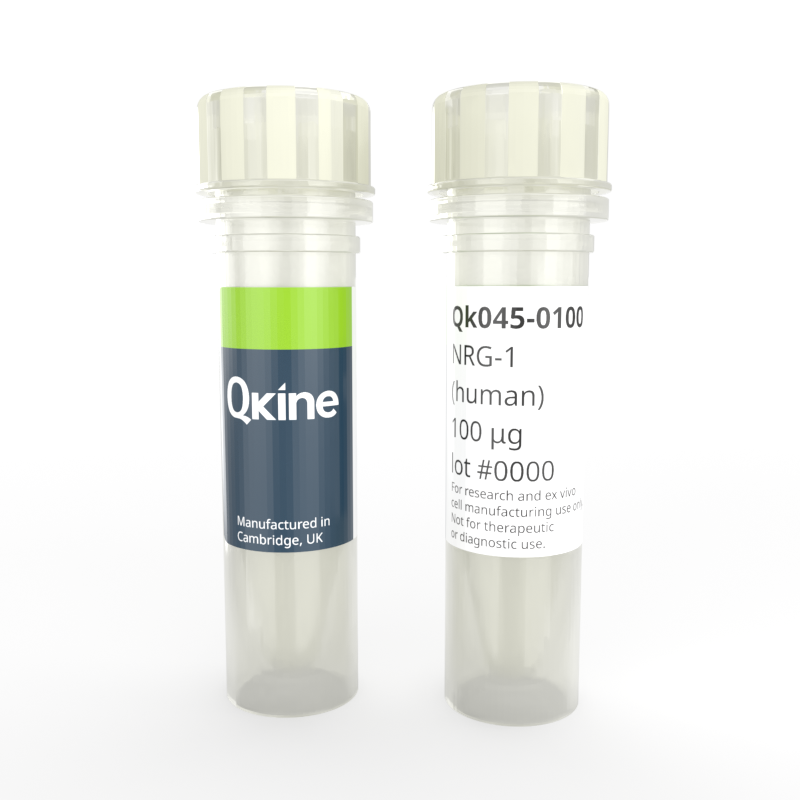Recombinant human NRG-1 protein
QK045
Brand: Qkine
Human NRG-1 protein (neuregulin 1) is frequently used in the maintenance of human pluripotent stem cells. In addition to its widespread use in stem cell culture media, NRG-1 (also known as Heregulin-β1 , HRG-1) has essential roles in vivo including in nervous system, cardiac, and mammary gland development; cancer biology and neurological disorders.
Qkine NRG-1 is the 7.5 kDa highly pure, bioactive domain of human NRG-1, comprised of the β isoform of the EGF-like domain of NRG-1 (HRG1-B1). This NRG-1 protein monomer is animal origin-free (AOF) and carrier-protein free (CF).

Currency:
| Product name | Catalog number | Pack size | Price | Price (USD) | Price (GBP) | Price (EUR) |
|---|---|---|---|---|---|---|
| Recombinant human/bovine/porcine NRG-1 protein, 50 µg | QK045-0050 | 50 µg | (select above) | $ 240.00 | £ 175.00 | € 205.00 |
| Recombinant human/bovine/porcine NRG-1 protein, 100 µg | QK045-0100 | 100 µg | (select above) | $ 315.00 | £ 230.00 | € 269.00 |
| Recombinant human/bovine/porcine NRG-1 protein, 500 µg | QK045-0500 | 500 µg | (select above) | $ 810.00 | £ 590.00 | € 690.00 |
| Recombinant human/bovine/porcine NRG-1 protein, 1000 µg | QK045-1000 | 1000 µg | (select above) | $ 1205.00 | £ 880.00 | € 1028.00 |
Note: prices shown do not include shipping and handling charges.
Qkine company name and logo are the property of Qkine Ltd. UK.
Alternative protein names
Species reactivity
human
species similarity:
mouse – 98%
rat – 83%
porcine – 100%
bovine – 100%
Frequently used together:
Summary
- High purity human NRG-1 protein (Uniprot: Q02297)
- 7.5 kDa
- >98%, by SDS-PAGE quantitative densitometry
- Expressed in E. coli
- Animal origin-free (AOF) and carrier protein-free
- Manufactured in Qkine's Cambridge, UK laboratories
- Lyophilized from acetonitrile, TFA
- Resuspend in sterile-filtered water at >50 µg/ml, add carrier protein if desired, prepare single use aliquots and store frozen at -20 °C (short-term) or -80 °C (long-term).
Featured applications
- Maintenance of pluripotency in human iPSC
Bioactivity
NRG-1 activity is determined using the Promega serum response element luciferase reporter assay (*) in transfected MCF-7 cells. Cells are treated in triplicate with a serial dilution of NRG-1 for 4 hours. Firefly luciferase activity is measured and normalized to the control Renilla luciferase activity. EC50 = 37.9 pM (0.28 ng/mL). Data from Qk045 lot #104317. *Promega pGL4.33[luc2P/SRE/Hygro] #E1340
.jpg?width=800&height=800&name=Qk045-Datasheet-graph_-NRG1%20(1).jpg)
Purity
NRG-1 migrates as a single band at 7.5 kDa in non-reducing (NR) conditions and upon reduction (R). No contaminating protein bands are visible. Purified recombinant protein (3 µg) was resolved using 18% w/v SDS-PAGE in reduced (+β-mercaptothanol, R) and non-reduced (NR) conditions and stained with Coomassie Brilliant Blue R250. Data from Qk045 batch #104317.
.jpg?width=600&height=599&name=210708-SDS-PAGE-NRG1-104317-3-ug%20(1).jpg)
Further quality assays
- Mass spectrometry: single species with expected mass
- Analytical reversed-phase: single sharp peak
- Endotoxin: <0.005 EU/μg protein (below level of detection)
- Recovery from stock vial >95%
Protein background
Neuregulin 1 (NRG-1) is a member of the neuregulin family (along with NRG 2-4). Each member of this family is encoded by an individual gene. Alternative splicing and different promoter utilisation results in a large number of isoforms for each member of the protein family – for example, NRG-1, the best studied member, generates six types of protein (I–VI) and at least 31 isoforms [1]. These isoforms have different tissue distribution, potency, receptor specificity and biological functions [2].
All NRG-1 isoforms contain the bioactive EGF-like domain, this EGF-like domain has two isoforms: alpha and beta. These differ in their receptor affinity; both the alpha and beta isoforms are ligands for the receptors ErbB3 (HER3) and ErbB4 (HER4), however the NRG-1 beta isoform has a higher affinity for the ErbB4 receptor than the alpha isoform [3]. This protein (Qk045) consists of the β isoform of the EGF domain of NRG-1 protein.
NRG-1 has an essential role in cardiac and neuronal development, and is implicated in disorders such as schizophrenia [4], and numerous cancers, for example breast cancer where NRG-1 promotes the proliferation and migration of breast cancer cells [5]. In cell culture, NRG-1 is frequently used in maintenance media for human pluripotent stem cells and other cells.
Background references
- Mei, Lin, and Wen-Cheng Xiong. ‘Neuregulin 1 in Neural Development, Synaptic Plasticity and Schizophrenia’. Nature Reviews Neuroscience, vol. 9, no. 6, June 2008, pp. 437–52. doi.org/10.1038/nrn2392.
- Breuleux, M. ‘Role of Heregulin in Human Cancer’. Cellular and Molecular Life Sciences, vol. 64, no. 18, Sept. 2007, pp. 2358–77. doi.org/10.1007/s00018-007-7120-0.
- Hobbs, Stuart S., et al. ‘Neuregulin Isoforms Exhibit Distinct Patterns of ErbB Family Receptor Activation’. Oncogene, vol. 21, no. 55, Dec. 2002, pp. 8442–52. doi.org/10.1038/sj.onc.1205960.
- Shi, Liang, and Clare M. Bergson. ‘Neuregulin 1: An Intriguing Therapeutic Target for Neurodevelopmental Disorders’. Translational Psychiatry, vol. 10, no. 1, June 2020, pp. 1–11. doi.org/10.1038/s41398-020-00868-5.
- Berdiel-Acer, Mireia, et al. ‘Stromal NRG1 in Luminal Breast Cancer Defines Pro-Fibrotic and Migratory Cancer-Associated Fibroblasts’. Oncogene, vol. 40, no. 15, Apr. 2021, pp. 2651–66. doi.org/10.1038/s41388-021-01719-3.
Publications using Recombinant human NRG-1 protein (Qk045)
Refined home-brew media for cost-effective, weekend-free hiPSC culture and genetic engineering
Truszkowski L, Bottini S, Bianchi S et al.
DOI: https://doi.org/10.12688/openreseurope.18245.1